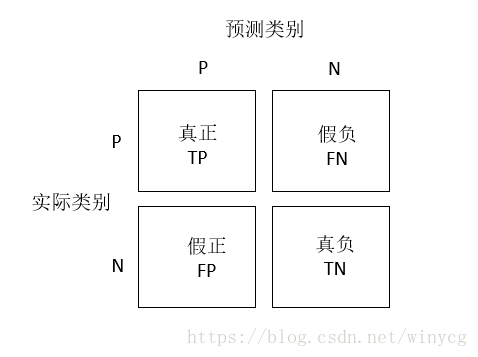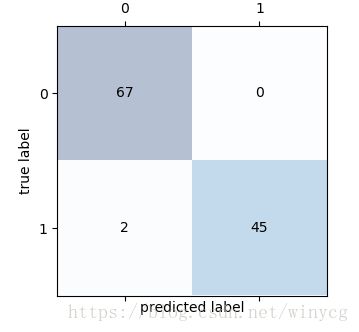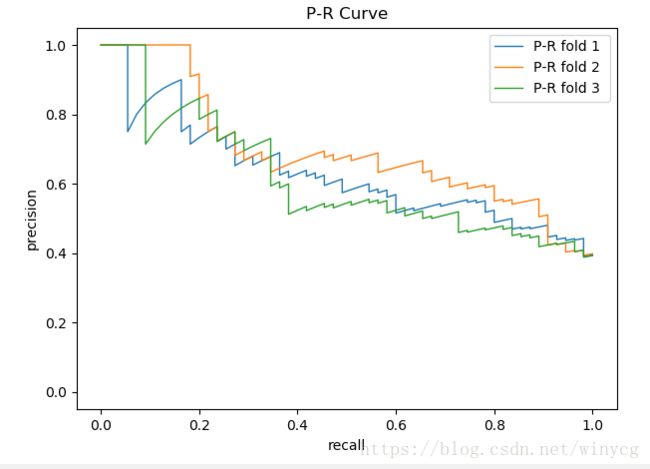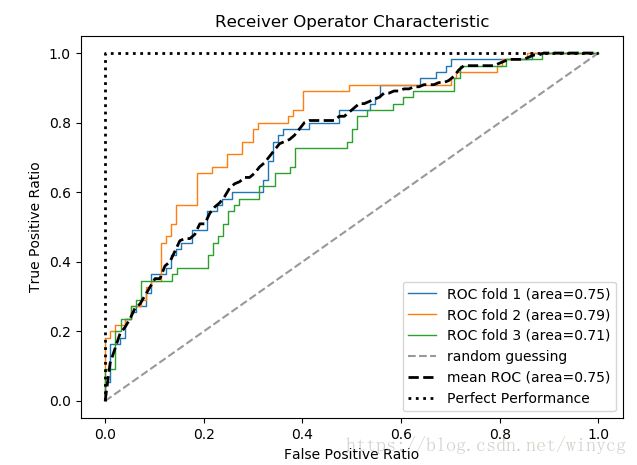分类器的不同的性能评价指标
参考链接:精确率、召回率、F1 值、ROC、AUC 各自的优缺点是什么?
读取混淆矩阵(confusion matrix)
混淆矩阵是一个2×2的方阵,用于展示分类器预测的结果——真正(true positive),假负(false negative)、假正(false positive)及假负(false negative)

sklearn中使用confusion_matrix函数实现:
import matplotlib.pyplot as plt
from sklearn.svm import SVC
from sklearn.preprocessing import StandardScaler
from sklearn.metrics import confusion_matrix
from sklearn.pipeline import Pipeline
import pandas as pd
import numpy as np
from sklearn.preprocessing import LabelEncoder
from sklearn.model_selection import train_test_split
'''
读取乳腺癌数据集
数据集前两列存储样本ID和诊断结果(M代表恶性,B代表良性)
3~32列包含了30个特征
'''
df = pd.read_csv('https://archive.ics.uci.edu/ml/machine-learning-databases'
+ '/breast-cancer-wisconsin/wdbc.data',
header=None)
X = df.loc[:, 2:].values
y = df.loc[:, 1].values
le =LabelEncoder()
# 将类标从字符串(M或B)变为整数的(0,1)
y = le.fit_transform(y)
X_train, X_test, y_train, y_test = train_test_split(X, y, test_size=0.2, random_state=0)
'''
在流水线中集成标准化操作以及分类器
PipeLine对象采用元组的序列作为输入,每个元组第一个值为字符串,
可以通过字符串访问流水线的元素,第二个值为sklearn中的转换器或评估器
'''
pipe_svc = Pipeline([
('scl', StandardScaler()),
('clf', SVC(random_state=0))
])
pipe_svc.fit(X_train, y_train)
y_pred = pipe_svc.predict(X_test)
confmat = confusion_matrix(y_true=y_test, y_pred=y_pred)
print(confmat)
'''
[[67 0
2 45]]
'''
fig, ax = plt.subplots(figsize=(2.5, 2.5))
ax.matshow(confmat, cmap=plt.cm.Blues, alpha=0.3)
# 给图形上文字,表示各情况的样本数量
for i in range(confmat.shape[0]):
for j in range(confmat.shape[1]):
ax.text(x=j, y=i, s=confmat[i, j], va='center', ha='center')
plt.xlabel('predicted label')
plt.ylabel('true label')
plt.show()从下图可以看出,模型正确预测出了类别为0的样本数量是67,还有45个属于类别1的样本。

精确率,召回率和P-R曲线
错误率(error,ERR)为预测错误的样本的数量与所有被预测样本数量的比值,而准确率(accuracy,ACC)为预测正确的样本的数量与所有被预测样本数量的比值。
查准率(precision,PRE)针对预测结果而言的,它表示的是预测为正的样本中有多少是真正的正样本。
查全率(recall,REC)针对样本而言的,它表示的是正样本中有多少被预测正确
P-R曲线:假设一共有20个测试样本,根据每个测试样本属于正样本的概率值从小到大排序。接下来,从高到低依次将概率值”值作为阈值threshold,当测试样本属于正样本的概率大于或等于这个threshold时,我们认为它为正样本,否则为负样本。由此可以得到20组precision和recall值,进而可以画出P-R曲线。
P-R曲线查准率=查全率的点称为平衡点(Break-Even Point,BEP),平衡点的值作为分类器性能的度量。

BEP过于简化,常用的F1度量
F1分数是精确率和召回率的调和平均数:
在算数平均数中,重要性取决于绝对值大的一方;调和平均数中,重要性取决于绝对值小的一方。
F1度量的一般形式为 Fβ F β ,可以表现出查准率和查全率的不同重要程度。
当 β=1 β = 1 时,为标准的F1度量。当 β>1 β > 1 时,查全率有更大影响;当 β<1 β < 1 时,查准率有更大影响
from sklearn.metrics import precision_score, recall_score,
f1_score, fbeta_score
print('Precision: %.3f' % precision_score(y_true=y_test, y_pred=y_pred))
print('Recall: %.3f' % recall_score(y_true=y_test, y_pred=y_pred))
print('F1: %.3f' % f1_score(y_true=y_test, y_pred=y_pred))
print('F_beta: %.3f' % fbeta_score(y_true=y_test, y_pred=y_pred, beta=0.8))
'''
Precision: 1.000
Recall: 0.957
F1: 0.978
F_beta: 0.983
'''ROC曲线
对于类别数量不均衡的分类问题来说,真正率(TPR)和假正率(EPR)非常有用:
受试者工作特征曲线(Receiver Operator Characteristic,ROC)是基于模型假正率和真正率等性能指标进行分类模型选择的工具。
参考链接: http://alexkong.net/2013/06/introduction-to-auc-and-roc/
假设一共有20个测试样本,根据每个测试样本属于正样本的概率值从大到小排序。接下来,从高到低依次将概率值”值作为阈值threshold,当测试样本属于正样本的概率大于或等于这个threshold时,我们认为它为正样本,否则为负样本。由此可以得到20组FPR和TPR值,进而可以画出ROC曲线。
AUC(Area Under the Curve)为ROC曲线下方区域的面积,面积的数值在1之内,一般都在0.5~1之间。使用AUC值作为评价标准是因为很多时候ROC曲线并不能清晰的说明哪个分类器的效果更好,而作为一个数值,对应AUC更大的分类器效果更好。完美性能的AUC为1,随机选择的AUC为0.5。
import matplotlib.pyplot as plt
from sklearn.svm import SVC
from sklearn.preprocessing import StandardScaler
from sklearn.linear_model import LogisticRegression
from sklearn.pipeline import Pipeline
import pandas as pd
import numpy as np
from sklearn.preprocessing import LabelEncoder
from sklearn.model_selection import train_test_split
'''
读取乳腺癌数据集
数据集前两列存储样本ID和诊断结果(M代表恶性,B代表良性)
3~32列包含了30个特征
'''
df = pd.read_csv('https://archive.ics.uci.edu/ml/machine-learning-databases'
+ '/breast-cancer-wisconsin/wdbc.data',
header=None)
X = df.loc[:, 2:].values
y = df.loc[:, 1].values
le =LabelEncoder()
# 将类标从字符串(M或B)变为整数的(0,1)
y = le.fit_transform(y)
X_train, X_test, y_train, y_test = train_test_split(X, y, test_size=0.2, random_state=0)
pipe_lr = Pipeline([
('scl', StandardScaler()),
('clf', LogisticRegression(penalty='l2', random_state=0))
])
from sklearn.metrics import roc_curve, auc
from scipy import interp
from sklearn.model_selection import StratifiedKFold
X_train2 = X_train[:, [4, 14]]
skf = StratifiedKFold(n_splits=3, random_state=0)
cv = skf.split(X_train2, y_train)
mean_tpr = 0.0
mean_fpr = np.linspace(0, 1, 100)
all_tpr = []
fig = plt.figure(figsize=(7, 5))
for i, (train, test) in enumerate(cv):
probas = pipe_lr.fit(X_train2[train], y_train[train]).predict_proba(X_train2[test])
# 根据概率获得fpr,tpr和阈值数据,pos_label指定了1作为正类别
fpr, tpr, thresholds = roc_curve(y_train[test], probas[:, 1], pos_label=1)
print(thresholds)
# 线性插值获得数据
mean_tpr += interp(mean_fpr, fpr, tpr)
mean_tpr[0] = 0.0
plt.plot(fpr, tpr, lw=1, label='ROC fold %d (area=%.2f)' % (i+1, auc(fpr, tpr)))
# 随机猜测ROC曲线
plt.plot([0, 1], [0, 1], linestyle='--', color=(0.6, 0.6, 0.6), label='random guessing')
mean_tpr /= i+1
mean_tpr[-1] = 1.0
plt.plot(mean_fpr, mean_tpr, 'k--', lw=2,
label='mean ROC (area=%.2f)' % (auc(mean_fpr, mean_tpr)))
# 完美性能ROC曲线
plt.plot([0, 0, 1], [0, 1, 1], lw=2, linestyle=':', c='k', label='Perfect Performance')
plt.xlim([-0.05, 1.05])
plt.ylim([-0.05, 1.05])
plt.xlabel('False Positive Ratio')
plt.ylabel('True Positive Ratio')
plt.title('Receiver Operator Characteristic')
plt.legend(loc='lower right')
plt.show()

如果仅获取ROC AUC的分数,可以直接使用sklearn.metrics模块中导入roc_auc_score函数,计算分类器在测试集上的ROC AUC得分:
from sklearn.metrics import roc_auc_score
from sklearn.metrics import accuracy_score
print(roc_auc_score(y_true=y_test, y_score=y_pred))
print(accuracy_score(y_true=y_test, y_pred=y_pred))在实际的数据集中经常会出现类不平衡(class imbalance)现象,即负样本比正样本多很多(或者相反),此时precision-Recall曲线会变化很大,ROC曲线基本不变。
原因是:假设数据集中只有100个positive instances,却有15200个negative instances,这属于极不均匀的数据集。假设分类器将1600 (1520+80)个instance分为positive,而其中实际上只有80个是真正的positive。 凭直觉来看,其实这个分类器并不好。但由于真证negative instances的数量远远大约positive, ROC的结果却很好,而PRC的precision可以判断出分类器性能较差。
多类别分类的评价标准
将二类别的评价标准通过一对多(One vs All,OvA)扩展到多分类问题。在k类别分类矩阵中,会有k个混淆矩阵。
微均值
将混淆矩阵对应的TP和FP元素相加,具体过程为:
宏均值
在各混淆矩阵分别求的查准率和查重率,再计算平均值。
当等同看待每个实例或者每次预测时,采用微均值‘;宏均值适用于类标样本不平衡的情况下,使用加权宏均值,各类别以类内实例的数量作为评分的权值。sklearn中将加权宏均值作为多类别问题的默认值,如果需要采用微均值,可以采用make_scorer函数创建一个计分器:
from sklearn.metrics import make_scorer
pre_scorer = make_scorer(score_func=precision_score,
pos_label=1,
average='micro')